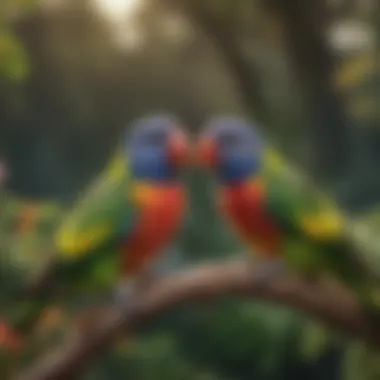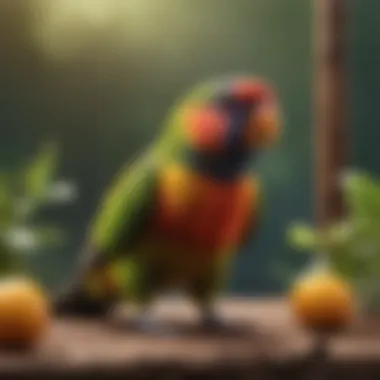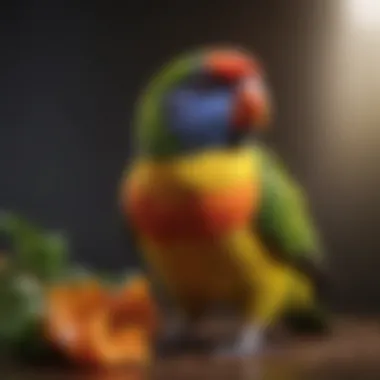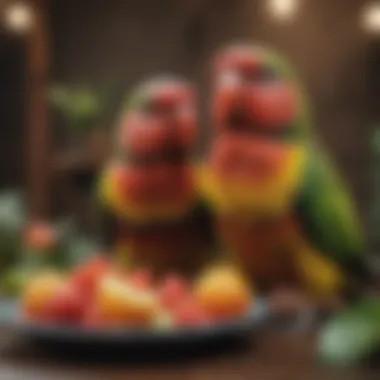Understanding Lorikeet Nectar: A Comprehensive Guide


Intro
Lorikeets are colorful and intelligent birds that require special care to thrive in a home environment. Understanding their unique dietary needs, particularly the importance of lorikeet nectar, is key to ensuring their health and happiness. Lorikeet nectar is not just a food source; it significantly influences the overall well-being of these vibrant creatures. In this guide, we explore the essential aspects of lorikeet nectar, covering its nutritional benefits, preparation, and feeding practices.
Understanding Your Pet
Pet Behavior Basics
Lorikeets are known for their playful and social nature. They thrive on interaction and require mental stimulation to prevent boredom. Understanding their behaviors can help you create an environment that nurtures their natural instincts. These birds often exhibit curiosity and can be quite vocal, which are normal characteristics of their social behaviors.
Common Breed Characteristics
Different lorikeet species have varying temperaments and preferences. For example, the Rainbow Lorikeet is often energetic and playful, while the Blue-streaked Lorikeet may be more reserved. It is essential for pet owners to recognize these breed-specific traits to tailor care effectively.
Species-Specific Needs
Each lorikeet species comes with unique dietary needs. The diet primarily consists of nectar but can also include fruits and vegetables. Knowing the specific requirements of your lorikeet can enhance its health and avoid potential digestive issues.
Pet Care and Maintenance
Feeding Guidelines
Lorikeets need a specialized diet that is rich in nutrients. Regular consumption of lorikeet nectar is crucial. It provides essential sugars and vitamins. However, it is also important to introduce a variety of fruits and vegetables. Aim for a balance that mimics their natural foraging behavior.
Grooming Essentials
While lorikeets do not require extensive grooming, periodic checking of their feathers and beak is important. Ensure their feathers are clean and free from any debris. This will not only promote good hygiene but also enhance their appearance.
Hygiene Practices
Maintaining a clean living environment is vital. Regularly clean the cage and remove old food. This practice helps prevent infections and keeps your pet healthy. Consider using bird-safe cleaning products to ensure their safety.
Training and Development
Basic Commands and Skills
Training lorikeets can be rewarding. Start with simple commands, like
Foreword to Lorikeet Nectar
Lorikeet nectar plays a pivotal role in maintaining the health and well-being of these colorful avians. Understanding this nectar is essential for pet owners, as it directly impacts the bird's diet and overall quality of life. In this section, we will discuss the basic definition of lorikeet nectar and its fundamental importance in a lorikeet's diet. This knowledge forms the foundation for making informed feeding decisions, which is crucial for their long-term health.
Defining Lorikeet Nectar
Lorikeet nectar, often derived from various floral sources, is a high-energy food designed specifically for the dietary needs of lorikeets. Unlike other parrot species that thrive on seeds and pellets, lorikeets have specialized tongues that allow them to extract nectar from blossoms. This nectar is not merely a sugary solution; it carries essential nutrients that sustain their unique metabolic systems.
The composition of lorikeet nectar can vary significantly depending on the plants from which it comes. Common sources include eucalyptus, banksia, and various flowering shrubs. Pet owners should understand that while commercial nectar mixes are available, they may not replicate the complexity and diversity found in the nectar produced by natural sources. Thus, familiarity with the properties and origins of lorikeet nectar is fundamental for any responsible pet owner.
Importance in Lorikeet Diet
The inclusion of nectar in a lorikeet's diet is crucial for several reasons. First, nectar serves as a primary energy source for these active birds. It is rich in carbohydrates, which are essential for maintaining energy levels throughout the day. Active lorikeets need a diet that can sustain their frequent movements and vocalizations.
Moreover, the nutritional content of natural nectar provides essential vitamins and minerals that contribute to overall health. It supports their immune system and promotes feather health, which is particularly important for their vibrant plumage.


Feeding lorikeets nectar also encourages natural foraging behaviors which are vital for their mental stimulation. This behavior can prevent boredom and related issues, such as destructive tendencies. Thus, understanding the importance of lorikeet nectar not only enhances physical health but also ensures a fulfilling life for pet lorikeets.
Regularly supplying appropriate nectar for your lorikeet can enhance their vitality and overall happiness.
Nutritional Composition of Lorikeet Nectar
Understanding the nutritional composition of lorikeet nectar is crucial for pet owners aiming to provide a balanced diet to their feathered companions. This section breaks down the essential vitamins, minerals, carbohydrates, and natural sugars found in nectar. Each element plays a significant role in promoting the health and vitality of lorikeets. Understanding these components can assist pet owners in making informed decisions about their feeding practices, ensuring these birds receive the right nutrients for optimal well-being.
Essential Vitamins and Minerals
Lorikeet nectar is rich in essential vitamins and minerals that support various bodily functions. Vitamins such as vitamin A, vitamin D, and several B vitamins are commonly found in commercial nectar formulations. These vitamins contribute to healthy feather growth, vision, and overall metabolic processes.
- Vitamin A is vital for maintaining proper vision and immune function. A deficiency can lead to serious issues like eye problems and a lowered resistance to infections.
- Vitamin D helps in calcium absorption, which is essential for strong bones and beaks. This mineral is especially important for young lorikeets that are still developing.
- B vitamins play various roles, including energy production and brain health. These vitamins help in metabolizing carbohydrates, which are the primary energy source for lorikeets.
In addition to vitamins, lorikeets require minerals such as calcium, phosphorus, and magnesium. Calcium is crucial for strong bones and eggshell formation in breeding pairs. Phosphorus supports energy transfer within cells, while magnesium plays a role in enzyme function.
Carbohydrate Sources
Carbohydrates are a primary source of energy for lorikeets. In nectar, carbohydrates mainly come from different sources like fructose and glucose. These simple sugars are readily absorbed and provide quick energy, which is necessary for lorikeets as they have high metabolic rates due to their playful and active nature.
- Fructose is naturally found in fruits and is a major component of nectar. It provides a readily available energy source for athletic activities like flying and climbing.
- Glucose is another critical sugar that plays a role in maintaining blood sugar levels and supporting energy during bursts of activity.
By understanding these carbohydrate sources, pet owners can formulate a diet that maintains energy levels and promotes a good quality of life for their lorikeets.
Natural Sugars and Their Role
Natural sugars, primarily derived from fruits and nectar itself, are essential for lorikeets. These sugars serve not only as energy sources but also contribute to the birds' palatability preferences.
Natural sugars enhance the taste and encourage lorikeets to consume their diet. An important point to remember is that while sugars are necessary, moderation is key. Excessive intake can lead to obesity and related health issues. It is best to balance nectar with other food items like fruits and vegetables to provide a diverse diet.
In summary, observing the nutritional composition of lorikeet nectar prepares pet owners to make sound dietary choices. This knowledge helps to establish feeding routines that benefit the health and happiness of their avian companions. Understanding how to balance vitamins, minerals, and sugars fosters an environment in which lorikeets can thrive.
Different Types of Lorikeet Nectar
Lorikeets are known for their vibrant colors and playful behavior. The nectar they consume plays a vital role in their well-being. Understanding the different types available helps pet owners provide the best care for these birds. The selection of nectar affects lorikeet health, energy levels, and even behavior. By knowing the options, one can make better decisions about what to feed their feathered friends.
Commercial Nectar Mixes
Commercial nectar mixes are a popular choice among pet owners due to their convenience. These products often come with detailed nutritional information. They are scientifically formulated to meet the dietary needs of lorikeets. Commercial mixes generally have a balanced blend of essential vitamins and sugars. Many brands are available in pet stores.
Sometimes, it might be difficult to decide which one to choose. Look for products that are specifically designed for lorikeets. Avoid those with fillers or artificial ingredients. High-quality mixes promote optimal health. Brands like Hagen and Kaylor of Colorado are known for their nutrient-rich nectars. They can ensure that your lorikeet stays active and healthy.
Homemade Nectar Recipes
Another approach for providing nectar is to make it at home. Homemade nectar can be a cost-effective and nutritious alternative. It allows pet owners to control the ingredients. A simple recipe involves mixing one part sugar with four parts boiling water. This mixture should cool before serving. Adding a bit of fruit juice can enhance flavor and nutrition.
When preparing homemade nectar, be careful with the sugar content. Over-sweetening can lead to health problems in lorikeets. You may also include various fruits in small amounts. Fruits such as mashed bananas or pureed berries can provide additional nutrients and variety in the diet.
Natural Sources in the Wild
In their natural habitat, lorikeets primarily feed on nectar from various flowers. Eucalyptus and banksia are examples of trees that provide nectar. Understanding these natural sources is crucial. It gives pet owners insight into what lorikeets enjoy. While it is not practical to replicate a wild diet, providing treats inspired by their natural feeding habits can be beneficial.
Moreover, fostering awareness of the lorikeets’ natural sources helps in supporting conservation efforts. The decline in these plants due to urbanization can impact lorikeets’ populations. Pet owners may consider planting flowering plants in their gardens. This action helps support local wildlife and offers a varied diet for their pet lorikeets.
Engaging with lorikeets' dietary preferences not only aids in their well-being but also instills a sense of environmental responsibility among pet owners.


Feeding Recommendations for Pet Lorikeets
Feeding lorikeets correctly is crucial for their overall health and well-being. The recommendations for feeding these birds emphasize their unique dietary needs and the ways to meet them. Lorikeets primarily consume nectar, but a well-rounded diet can improve their quality of life. Following proper feeding guidelines ensures that pet owners provide the right nutrition while keeping these colorful birds active and happy.
Daily Nectar Intake Guidelines
Understanding the daily nectar intake for lorikeets is vital in maintaining their energy levels and overall health. On average, lorikeets should consume about 10% of their body weight in nectar every day. This ratio can vary based on factors like the bird's age, size, and physical activity.
It's important to monitor their consumption to ensure they are getting enough nourishment. A lack of nectar can lead to malnutrition, while excess can result in obesity. Therefore, keep the feeding area clean and observe the amount consumed each day.
Key Points for Daily Intake Guidelines:
- Monitor weight: Track the weight of your lorikeet regularly to adjust nectar intake if necessary.
- Observe activity: A more active bird may require more nectar to maintain energy levels.
- Freshness matters: Provide fresh nectar daily to ensure good health and prevent spoilage.
Combining Nectar with Other Foods
While nectar forms the base of a lorikeet's diet, it is beneficial to combine it with other foods for a balanced nutrition profile. Fruits, vegetables, and specially formulated pellets can complement their diet. Fruits like apples, bananas, and papayas provide essential vitamins. Vegetables such as carrots and leafy greens contribute to fiber intake.
Incorporating these foods keeps meals interesting and provides a larger spectrum of nutrients. Maintain a varied diet for your lorikeet to prevent behavioral issues caused by boredom or dissatisfaction with food.
Recommended Foods to Combine with Nectar:
- Fresh fruits: Apples, bananas, and berries.
- Fresh vegetables: Spinach, carrots, and sweet potatoes.
- Specialty pellets: Designed for lorikeets to supply vitamins and minerals not found in nectar alone.
Understanding Portion Control
Portion control is essential when feeding lorikeets. Overfeeding can lead to obesity, while underfeeding can cause malnutrition. Knowing how much nectar and additional food to provide prevents health issues. As a general rule, start with small portions and adjust based on your bird's eating habits.
When providing nectar, use a feeder that allows your lorikeet to consume it slowly. This technique can aid digestion. Other foods should follow a similar approach, ensuring that lorikeets do not consume everything at once.
Portion Control Guidelines:
- Measure servings: Start with 1-2 tablespoons of nectar, adjusting as necessary.
- Temperature control: Ensure food is fresh and at room temperature.
- Regular checkups: Consult with a vet for personalized feeding recommendations based on your lorikeet's health status.
Proper feeding ensures a healthy, vibrant lorikeet that thrives in your care.
Health Considerations Related to Lorikeet Nectar
Health considerations are paramount when caring for pet lorikeets. Understanding how nectar affects their health helps owners optimize the well-being of these vibrant birds. This section delves into important factors like allergies and nutritional balance, ensuring pet owners can provide safe and nutritionally adequate diets.
Potential Allergies and Reactions
Lorikeets can have specific sensitivities to ingredients found in nectars. Pet owners must be aware of the types of nectar they use. Common allergens include certain fruit bases or additives. Some lorikeets may develop allergic reactions, leading to symptoms such as feather plucking, digestive upset, or unusual behaviors. Monitoring essential aspects like the bird's response to new items is crucial. If any sign of a reaction occurs, discontinue use and consult a veterinarian.
It is important to introduce new nectar types gradually. Doing this allows time to observe any adverse reactions. Employing a food journal can help track food intake and health changes. Such methods provide a clear picture of what suits each bird best. Additionally, discussing specific nectar options with avian veterinarians can provide further insights about safety.
Signs of Nutritional Imbalance
Nutritional imbalance can stem from improper nectar feeding or lack of diverse foods. Lorikeets thrive on a varied diet, and nectar should not be their only source of nutrition. Owners need to be vigilant about symptoms indicating nutritional deficiencies. Symptoms can include lethargy, dull plumage, and decreased activity.
An inadequate supply of vitamins can lead to specific health issues. For example, deficiencies in calcium may result in weak bones or feather abnormalities. Conversely, excess sugar intake can also be harmful, leading to obesity or diabetes. To ensure nutritional balance, owners should regularly adjust the types of nectar and supplementary foods offered.
Regular veterinary check-ups can help monitor lorikeet health and identify any early signs of nutritional imbalance.
Behavioral Aspects Linked to Nectar Consumption


Understanding the behavioral aspects linked to nectar consumption in lorikeets sheds light on the social dynamics and activity patterns of these birds. Nectar not only serves as a primary food source but also influences how lorikeets interact with one another and their environment. Recognizing these elements helps pet owners provide a stimulating and fulfilling habitat for their avian companions.
Nectar as a Social Stimulus
Nectar acts as a significant social catalyst for lorikeets. In the wild, these birds often feed in flocks, which fosters a sense of community. When multiple birds gather around a nectar source, they engage in distinct behaviors, such as vocalizations and preening, which strengthen social bonds.
- The presence of nectar stimulates competition and sharing among lorikeets. This competition can lead to playful interactions, enhancing their social skills. In captivity, providing a shared nectar source can replicate this communal feeding experience, encouraging friendly behavior between pet lorikeets.
- Moreover, social feeding enhances overall well-being. It can reduce stress and promote a sense of security, as lorikeets are naturally inclined to be social animals. Ensuring they have opportunities to interact with each other while feeding can help maintain their mental health.
Research indicates that social interactions during feeding can significantly influence the psychological health of pet lorikeets. Ensuring social engagement is key for a joyful and healthy pet experience.
Impact on Activity Levels
The consumption of nectar directly correlates with the activity levels of lorikeets. These birds are high-energy creatures, and their nutritional intake plays a vital role in maintaining their vigor.
- Nectar, rich in sugars, provides a quick source of energy, which is essential for their active lifestyle. When lorikeets consume this sweet sustenance, they tend to exhibit increased playfulness and exploration within their environment.
- Additionally, higher energy levels translate into more exercise. Parrots, including lorikeets, require ample physical activity to keep their muscles healthy and robust. Offering nectar encourages them to engage in flight and climbing, promoting better physical health.
- However, moderation is essential. While nectar boosts energy, overconsumption can lead to obesity and health issues. Thus, understanding the right balance is crucial for maintaining optimal activity levels without risking their health.
By grasping the behavioral aspects tied to nectar consumption, pet owners can create an enriching environment that mirrors their natural habits. This awareness contributes to happier, healthier lorikeets, as their social and physical needs are met effectively.
Environmental Impact on Lorikeet Nectar Availability
The availability of lorikeet nectar is significantly influenced by environmental factors. Understanding these impacts is crucial for pet owners who want to ensure their birds receive the appropriate nutrition. The connection between habitat and nectar sources directly affects the well-being of lorikeets. Without access to suitable habitats, the delicate balance of their diet may be disrupted, leading to nutritional deficiencies.
Habitat Loss and Urbanization
Habitat loss poses a serious threat to lorikeet populations. Urban development results in deforestation and the destruction of natural landscapes where nectar-producing plants thrive. As cities expand, green spaces shrink, leaving lorikeets with fewer resources.
- Reduction in Plant Species: Urbanization often leads to the removal of native flora. Many nectar-producing plants, such as eucalypts and banksias, are essential for lorikeets. With fewer of these plants available, lorikeet food sources diminish.
- Isolation of Habitats: Urban areas can fragment habitats, making it difficult for lorikeets to locate and access nectar. These changes can lead to decreased competition for food but also isolate populations, reducing genetic diversity.
- Pollution: Increased pollution in urban settings also impacts the quality of nectar. Pollutants can affect plant health, which in turn affects the quantity and quality of nectar that lorikeets rely upon.
Conservation Efforts for Nectar Sources
Conservation initiatives are vital in maintaining the availability of lorikeet nectar. They aim to restore habitats and protect essential plant species.
- Habitat Restoration Projects: Many organizations work to restore native plant populations. Efforts include planting native trees and shrubs that provide nectar for lorikeets. This restoration not only benefits lorikeets but also supports other wildlife.
- Community Awareness and Involvement: Engaging local communities is essential for conservation. Educating pet owners and residents about the significance of native flora can lead to more support for these initiatives. A well-informed public can take part in planting and preserving local habitats.
- Legislation Protection: Protecting existing habitats through legal frameworks is crucial. Governments can implement policies to safeguard natural areas from urban encroachment, ensuring that lorikeets have access to their nutritional resources.
Maintaining the environmental integrity of lorikeet habitats is not just crucial for the birds but for the ecosystem as a whole.
Epilogue
In assessing the significance of lorikeet nectar, it becomes clear that this component plays a vital role in both the diet and overall well-being of these captivating birds. The discussion throughout the article highlights not just the nutritional importance of the nectar but also its implications on behavior, health, and environmental factors. Understanding these elements is crucial for pet owners who aim to provide the best care for their lorikeets.
Deciphering the nutritional makeup of lorikeet nectar is essential, as it contains vital vitamins, minerals, and sugars that support an active lifestyle. The insights gained from exploring its various sources, both commercial and natural, equip pet owners with the knowledge to select the best options for their feathered companions. This consideration is crucial in maintaining a balanced diet that can enhance a lorikeet's vibrancy and energy levels.
"Proper nutrition is the cornerstone of a healthy life for lorikeets, and nectar plays a key part in achieving this goal."
The article has also addressed the behavioral impacts of nectar consumption. Understanding how nectar influences social interaction and activity is beneficial for owners looking to foster a stimulating environment. Moreover, recognizing the potential environmental threats impacting nectar availability can lead to more informed choices regarding conservation and sourcing.
In summary, having a comprehensive understanding of lorikeet nectar not only enriches the life of these unique birds but also fosters a stronger bond between pet owners and their feathered friends. Investing time to learn about these aspects results in a healthier and happier lorikeet, ultimately leading to a fulfilling companionship.
Summarizing Key Takeaways
- Nutritional Role: Lorikeet nectar is rich in essential nutrients that support your bird’s health and vitality.
- Feeding Practices: Utilizing both commercial and homemade nectar recipes provides a diverse and balanced diet for lorikeets.
- Behavioral Influence: Nectar significantly influences social interactions and play behaviors among lorikeets.
- Environmental Awareness: Understanding the impacts of habitat loss can inform better sourcing and care practices.
In essence, these takeaways form a foundation for effective care, ensuring that lorikeets receive the balanced diet they need to thrive.
Future Considerations in Lorikeet Care
Looking ahead, several aspects warrant attention for those committed to lorikeet care. Firstly, it is important to stay informed about new research related to lorikeet nutrition. Innovations in dietary recommendations are continually emerging, and being abreast of these changes can significantly benefit your lorikeet’s health.
Sourcing nectar from sustainable methods should also be a priority. As urbanization continues to threaten natural habitats, pet owners need to support ecologically sound practices that contribute to the conservation of nectar sources.
Lastly, continuing to monitor your nebula’s health through regular veterinary check-ups remains essential, especially concerning any signs of nutritional imbalance or allergies. Maintaining a flexible and well-informed approach ensures your lorikeet thrives in a nurturing environment.







